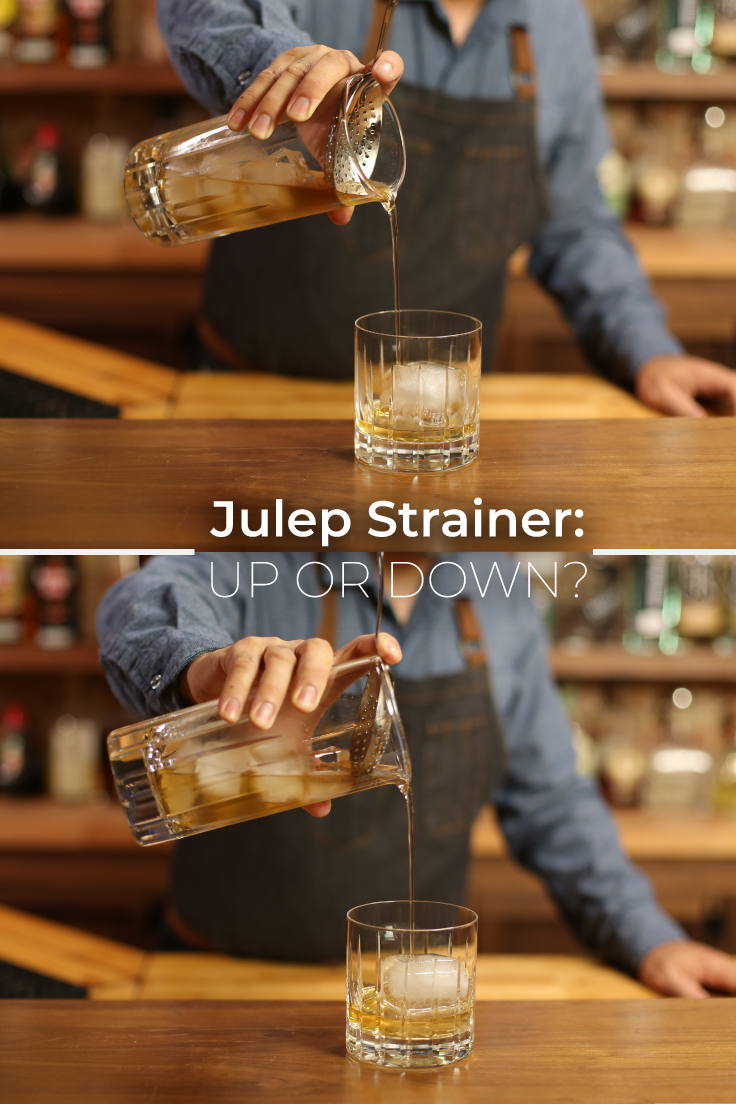The Great Debate:
Which Way do you Use your Julep Strainer?
Until recently, I thought there was a “right” way and a “wrong” way to hold your julep strainer. I assumed the way Chris did it (bowl facing down, curve facing up, as shown on the right above) was just “how it’s done”. But then I actually asked him about it and found out that it’s actually a matter of personal preference.
First, a Brief History Lesson
Julep strainers are so named because of their original purpose – they were designed for the drinker to put into their glass to hold back the crushed ice and mint while they drink their Mint Juleps. (Especially important if you had a moustache.) Eventually the task of straining a cocktail became the job of the bar man and the Hawthorne Strainer was invented, taking much of the julep strainer’s glory.
The only reference I could find which specifically illustrated the direction of the strainer back in the 1800’s was this patent from 1890, clearly with the strainer facing down.
Inspired further by this conversation in our Facebook group, I thought I’d do a little research. Here’s what I learned.
“Bowl” facing Down (Convex side toward the top)
The first thing to note is that the vast majority of “how to” resources on the web recommend this method, with the spoon facing down, “cupping” the ice. Few said why.
The bartenders in our Facebook group who used this approach recommended it because it allows more room for ice (especially when mixing multiple cocktails) and some found that it fits some mixing glasses better.
Personally I find it a bit easier to hold, as I have small hands and the strainer doesn’t sit as deeply into the glass / shaker.
“Bowl” facing up (Convex side toward the bottom)
I didn’t find a single resource telling folks to hold their julep strainers this way, but that doesn’t mean it’s wrong. Some preferred it because, as you pour, the weight of the ice helps keep the julep strainer in place. This orientation situates the julep strainer deeper into the glass, which can be more comfortable if you have larger hands or if you are mixing a smaller (single) cocktail.
One person even mentioned that they do it this way because they felt it looked harder and therefore provided a better guest experience (my words). Can’t argue with that!
The Counterpoint: The Hawthorne Strainer
Of course, the Hawthorne Strainer replaced most of the julep strainers behind the bar and for good reason: in a lot of ways, it’s just a much better strainer. Some bartenders agreed and said they don’t bother with the julep strainer at all, sticking with the Hawthorne. (And in some cases relegating the julep strainer to scooping olives out of the olive jar.)
The Verdict? Strain how you like!
As always, it depends! The one message that came through loud and clear in the comments is that it actually depends a lot on the julep strainer and mixing glass. Some work better facing up and some work better facing down. So do what works for the equipment (and hands) that you have, and I’m not going to tell you how to do your job!
Julep Strainer – Top Shelf Bar Supply
Yarai-style mixing glasses are much higher quality than they were five years ago. This one is also seamless, which increases its durability.





